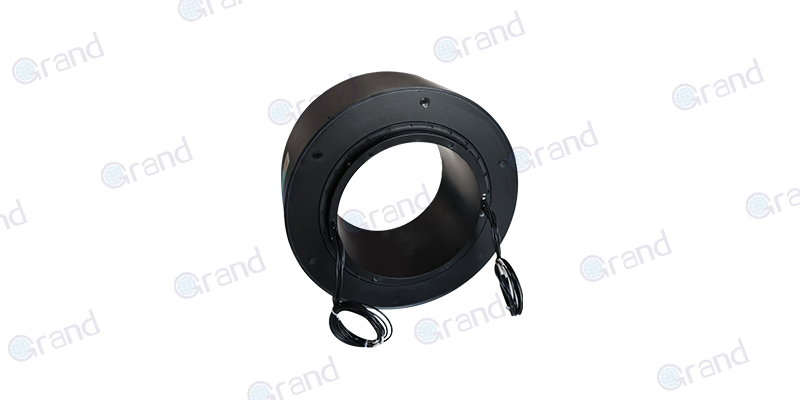In the realm of industrial engineering and manufacturing, accuracy and consistent performance are of paramount importance. A key component facilitating these elements is a specialized device known as a Slip Ring Torque Sensor. Playing a central role in various complex machinery and systems, these sensors are precision instruments designed to measure torque on a rotating system, including motor systems, crankshafts, gearboxes, capstan, or rotorcraft component vehicles.
Essentially, slip ring torque sensors convert mechanical torsional strain into readable electrical output data. This conversion forms the basis of their working principle, and allows them to serve as reliable and critical components for regulating performance in a rotating system.
The range of applications for slip ring torque sensors is broad, covering an array of industries, from automotive and manufacturing to wind energy and aerospace. Their role in these sectors is crucial as they facilitate enhanced control, effective performance analysis, and preventative maintenance measures. Their accuracy, reliability, and capacity to withstand harsh operational conditions make them indispensable in today’s demanding industrial scenario.
This article provides a comprehensive exploration of slip ring torque sensors, their workings, types, key applications, as well as user concerns and emerging trends shaping their future prospects. As we delve deeper into this subject, we aim to highlight their significant role, illustrating why these devices hold a pivotal position in the engineering landscape and how they promise to shape the future of industrial operations.
Slip Ring Torque Sensors: Working Principle
To understand the crucial role that slip ring torque sensors play in various sectors, we must first delve into their operational mechanism and basic structure. The working principle of these sensors is anchored in the concept of converting mechanical input – specifically, torsional strain – into an interpretable and measureable electrical output.
Basic Structure
At the heart of a slip ring torque sensor is the slip ring assembly, encompassing several individual components that collectively create the functionality of the sensor. This assembly includes the rotor (which is connected to the rotating part of the machine generating torque), the stator (which remains stationary), and the brushes, which transmit the signal across the rotating interface. The slip ring assembly plays an important part in ensuring that electrical connectivity is maintained, without influencing the torque that is being measured.
Operational Mechanism
Slip ring torque sensors function by detecting torsional deflection resulting from a applied torque in a rotating system. When a mechanical torque is applied to the sensor’s shaft, the strain gauges embedded in the assembly deform proportionally to the torque. This deformation alters the electrical resistance of the strain gauge in a way that can be precisely measured.
The brushes and slip rings continuously maintain electrical contact as the shaft rotates, thereby enabling electrical data and signal transmission even during continuous rotation. This process allows the sensor to provide real-time, accurate measurements of torque regardless of rotational speed.
The transduction of mechanical strain into electrical signals forms the basis of categorizing the sensor output. The measurement data gets amplified, resulting in a stronger output signal for accurate and immediate data interpretation and usage.
In sum, the working principle of slip ring torque sensors hinges on the elegant conversion of mechanical force into electrical signals. This efficient transduction, paired with the capacity to monitor rotational systems with high precision, makes these sensors instrumental within multiple industrial applications.

Different Types of Slip Ring Torque Sensors
Slip ring torque sensors are not a one-size-fits-all solution. In fact, there exist various types of these sensors that have been engineered to meet a spectrum of specific industrial requirements. The different varieties cater to varying complexities of applications, each showcasing unique features and performance characteristics, allowing their suitability for a range of equipment and operations.
Rotary Torque Sensors
Rotary torque sensors are designed to measure torque directly on moving parts and are most effective when torque needs to be measured without stopping the system operation. Equipped with superior slip ring technology, these sensors provide highly accurate, real-time measurements under dynamic conditions. They are well-suited for applications like engine testing and dynamometer systems, where rotational speed and direction variations are common.
Shaft-to-Shaft Sensors
Specifically designed for inline measurements, shaft-to-shaft torque sensors utilize slip ring technology to transfer torque readings from rotating shafts. They are commonly used in situations where physical connections between components are essential—such as in drivelines or pumps. Here, the sensor is positioned between two interfacing shafts, measuring the torque transferred between them.
Flange Torque Sensors
Flange torque sensors, also known as reaction torque sensors, are the go-to sensors when you need to evaluate the static torque or measure the torque where rotary motions are limited. These sensors are fitted onto a flange and provide a stationary measurement platform. Typically, you would find them used in applications such as component testing, twist testing, or switch breakaway testing.
Customizable Torque Sensors
Given the diverse needs of different industries, customizable torque sensors have started making a mark. These sensors pass through a unique designing stage, which allows them to be tailor-made for specific industrial setup requirements. This ability to be customized means they can be adapted to harsh environments, space constraints, or extreme load conditions, where standard sensors may not perform satisfactorily.
Each type of slip ring torque sensor possesses a unique set of features that make them suitable for certain types of applications. Understanding these characteristics can aid in selecting the right sensor type for specific applications, ensuring optimal performance and accurate measurements. The key is to align the nature of the sensor with the requirements and conditions of the task in hand.
Slip Ring Torque Sensors: Key Applications
As versatile and indispensable components in the realm of mechanical engineering and industrial operations, slip ring torque sensors are found in a vast array of applications. Their ability to provide accurate, real-time torque measurement, irrespective of the rotational speed, makes them a crucial part of numerous industrial sectors.
Aerospace Industry
In aerospace applications, slip ring torque sensors are used to monitor and regulate the torque output in a variety of pivotal aerospace components. They aid in testing and monitoring the performance of turbine engines, propellers, and other rotary parts of an aircraft. The data acquired from these sensors enables the detection of potential performance inefficiencies, providing opportunities for preventative maintenance and thus enhancing flight safety.
Automotive Industry
In the automotive sector, these sensors are employed in powertrain testing, engine performance evaluation, transmission testing, and brake testing. They provide valuable insights about the parameters like force, speed, and torque applied in various automotive systems, allowing engineers to tweak and optimize vehicle performance based on real-time data.

Wind Energy Sector
In the generation of wind energy, torque sensors furnish critical information about the performance of wind turbines. They measure the stress and strain on the turbine blades, helping to optimize their operational efficiency. Accurate measurement of torque can prevent overloading and blade damage, increasing the lifespan of the turbine and facilitating efficient energy production.
Testing Laboratories
Testing laboratories often utilize slip ring torque sensors for a variety of tests, such as material strength testing, dynamic torque analysis, and fatigue testing. Their precise and reliable readings support robust research outcomes, furthering our understanding of material properties and system performance.
Marine Industry
In marine applications, these sensors play a key role in testing and monitoring the propulsion system. They are used to measure the shaft power and torque in marine engine drive systems, providing data that helps maintain the engine’s performance.

In each of these applications, the slip ring torque sensor’s ability to accurately measure and monitor rotational torque proves invaluable. Its own mechanical durability and endurance, even in demanding operational environments, further solidify its standing as a crucial tool in myriad industrial applications.
User Concerns Regarding Slip Ring Torque Sensors
As with any technologically advanced tool utilized in industrial settings, using slip ring torque sensors comes with its set of concerns. These concerns, arising from a variety of factors such as accuracy, durability, customization, maintenance, installation, and costs, help shape future development directions and dictate necessary advancements for the user community.
Accuracy
The need for precise measurements is of the essence in all applications where slip ring torque sensors are employed. Slight inaccuracies can significantly interfere with system performance and compromise safety. Therefore, users are concerned about any potential conditions that may influence the sensor’s readings, such as ambient temperature variations, non-linearity, hysteresis, or a shift in the zero point.
Durability
Due to their use in demanding industrial environments that may involve high temperature, pressure or corrosive conditions, the durability of slip ring torque sensors is a key concern. The sensor must withstand harsh operational circumstances while maintaining consistent performance and reliability.
Customization
Given the wide range of applications and variable conditions in which slip ring torque sensors are utilized, there is often a need for customization. Users may require sensors that fit specific spatial constraints, withstand unique environmental conditions, or accommodate specific torque and speed ranges.
Maintenance and Installation
Ease of maintenance and installation are significant considerations. Users generally prefer sensors that require minimal maintenance and are easy to install or replace. A complicated installation process or frequent upkeep can lead to increased downtime and costs.
Costs
The financial investment involved in implementing and maintaining slip ring torque sensors is a major concern. This includes the cost of the sensor itself, installation costs, maintenance costs, and even the cost of potential downtime during installation or repair.
Addressing these issues is crucial for manufacturers and suppliers of slip ring torque sensors, as user satisfaction and operational efficiency largely depend on these factors. By continually working on research and development to mitigate these concerns, manufacturers can significantly enhance the user experience and the overall performance of these sensors.
Slip Ring Torque Sensors: Overcoming User Concerns
Given the numerous concerns users may have regarding the utilization of slip ring torque sensors, the following solutions and strategies can be put into action to mitigate these challenges, leading to improved user experience and operational reliability.
Regular and Preventive Maintenance
Planned, regular maintenance can help identify issues before they escalate, thus ensuring the sensor’s accuracy and long-term reliability. This includes cleaning and inspection, as well as regular calibration to ensure the sensor continues to provide accurate readings. While this requires dedicated time and resources, it can significantly reduce potential costly repairs and unexpected downtime.
Choosing the Right Sensor
Selecting an appropriately designed sensor for a particular application is paramount. Different sensor types offer varying performance in different environments and usage scenarios. By analyzing the functional requirements, environmental conditions, and specific application needs, users can choose a sensor that offers optimal performance and durability, thereby reducing potential issues related to wear and tear or inaccurate readings.
Considering Long-Term Value Over Initial Cost
While the initial cost of a high-quality slip ring torque sensor may be greater, its long-term value should not be underestimated. Good quality sensors usually come with enhanced accuracy, improved durability and may require less frequent maintenance. Even though they might carry a higher price tag initially, they can lead to significant savings over time in the form of reduced downtime, lower maintenance costs, and superior operational efficiency.
Customized Solutions
In cases where standard sensors do not meet the user’s unique requirements, customized solutions can be considered. Manufacturers can develop sensors tailored to specific needs, ensuring compatibility with unique operational environments and functional requirements. Although this might increase the initial investment, it can lead to better performance and lesser challenges in the long run.
Training for Proper Installation and Operation
Providing adequate training to the staff involved in the installation and operation of the sensors can also mitigate many user concerns. When individuals thoroughly understand the sensor’s operation and the implications of improper handling or installation, there is less chance of error, leading to improved sensor function and lifespan.
Overcoming user concerns is a multi-faceted process, involving a combination of meticulous selection, regular maintenance, custom solutions, adept understanding, and a willingness to prioritize long-term value over short-term costs. Through these solutions and strategies, users can fully exploit the benefits of slip ring torque sensors while managing the potential challenges that come with their use.
Slip Ring Torque Sensors: Care & Maintenance for Longevity
Proper care and maintenance of slip ring torque sensors can greatly prolong their lifespan and ensure they continue to provide accurate and reliable readings. Here’s a rundown of practices and a suggestive maintenance schedule to enhance the longevity of these sensors.
Regular Inspections
All slip ring torque sensors should be inspected regularly for any signs of wear and tear that could indicate potential weakness or failure. This might include looking for any loose connections, assessing wear on the slip rings, or spotting damage on any component. If any signs of deterioration are found, it’s essential to take corrective action promptly. Depending on the operational environment, inspections should ideally be scheduled weekly or monthly.
Proper Cleaning
Slip ring torque sensors need periodic cleaning to remove any dust or debris that might have accumulated, as this could affect their performance. Special attention should be paid to the slip ring contacts, ensuring they are kept clean for optimal signal transfer. Non-abrasive cleaning materials should be utilized to avoid causing any damage. Depending on the environment, this might need to be done on a monthly basis.
Periodic Calibration
To ensure the accuracy of the torque sensor, regular calibration is important. It helps in compensating any potential errors that might be introduced over time due to factors such as temperature fluctuations or vibrations. Calibration frequency depends on usage and should follow the manufacturer’s guidelines. However, a good rule of thumb is to calibrate at least once a year or whenever you have concerns about accuracy.
Timely Replacements
Even with the best care, certain components of a slip ring torque sensor will eventually need replacement. This includes the contact brushes on the slip rings, which will wear out over time and require replacement to ensure uninterrupted signal transfer. Following the manufacturer’s guidelines for replacement frequency is recommended.
Avoiding Overload
Continual or excessive overloading the torque sensor can lead to premature failure. Always ensure to operate your sensors within torque limits specified by the manufacturer.
Proper Storage
When sensors are not in use, they should be stored properly in a clean, dry, and controlled environment to avoid potential damage.
Effective maintenance is a vital commitment that ensures increased longevity and performance of your slip ring torque sensors. By following these practices within an appropriate schedule, you can benefit from improved reliability, reduced downtime, and maximize your investment in the long run.
Slip Ring Torque Sensors: Emerging Trends & Future Prospects
The world of slip ring torque sensors is not static; it continues to evolve with advancements in technology, changes in industry requirements, and the drive towards sustainability. Here are several emerging trends and future prospects that are set to shape the future of this field.
Advances in Materials
Material science provides tremendous potential for advancing the capabilities of slip ring torque sensors. New, more resilient materials for making slip rings could result in sensors that offer improved durability and higher resistance to extreme environments. Such materials could also reduce the need for frequent maintenance and replacements, enhancing the overall lifespan of the sensor.
Integrated Digital Technology
The integration of digital technology into slip ring torque sensors is a significant trend. Enhanced with IoT capability, sensors could provide real-time data, wireless communication, and seamless integration with other devices. Such digital integration enables predictive maintenance, remote monitoring, and even machine learning capabilities, optimizing the overall system efficiency.
Sustainable Production Practices
As with many industries, the push towards more sustainable and greener manufacturing processes is becoming a trend. This involves designing energy-efficient sensors, using recyclable materials, minimizing waste during manufacturing, and promoting sensor longevity to reduce the frequency of replacements.
Customization
Given the diverse needs of different industries and applications, customization in torque sensor design is becoming increasingly important. Customized sensors are designed to fit unique operational environments or meet specific functional requirements. They offer better compatibility and performance and are likely to become more prevalent in the future.
Wireless Technology
Wireless technologies in slip ring torque sensors may eliminate the need for physical connections, thereby overcoming the inherent limitations of mechanical wear and friction. This also allows for more flexible installation options and potentially improves sensor lifespan.
Overall, the future for slip ring torque sensors looks promising with continual advancements geared towards improving their performance, reliability, sustainability, and ease-of-use. These developments not only cater to the ever-evolving needs of industries but also contribute to enhancing the durability and flexibility of these critical components in various machines and systems.
Conclusion
In essence, slip ring torque sensors play an integral role in modern industrial operations. Through continuous improvements, meticulous maintenance, and adaptation to emerging trends, these systems promise to deliver improved performance and reliability, proving their inevitable importance in the realm of mechanical and industrial engineering.
See What We Can Do
